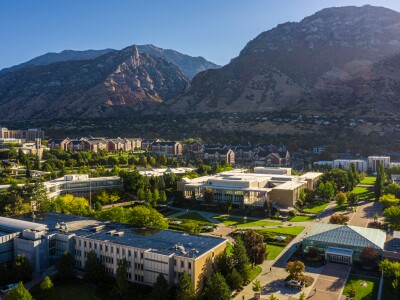One Tip: Less watering doesn't necessarily mean dead lawns

BYU Civil and Construction Engineering professor Rob Sowby has contributed to over 200 civil engineering projects throughout North America, including many which address sustainable water supply. With the current drought crisis in the Mountain West, he’s refining his efforts to be most helpful to water suppliers, policy makers and residents here in Utah. We asked Sowby a handful of questions that are on our minds (and on the minds of many Utahans) as the drought persists into yet another dry summer.
Q: First things first: Tell us about your latest research on water in Utah.
A: We wanted to know how much people irrigate, how big their yards are and how healthy their grass is. You rarely get to see all those things at once, but now we have the technology to do it. We used aerial photography of land parcels and mined the secondary water bills of thousands of anonymous customers in two Utah County cities with different water rates. We found that if you water too much, your lawn will actually be less healthy. Plant scientists know that (you can see that effect in the lab or greenhouse), but we observed it across two cities over a whole summer month. It’s a real portrait of how typical Utahans irrigate.
Q: How would someone know if they’re watering too much?
A: Flip a coin. Roughly half of those in the study were overwatering and harming their landscapes. You can still have a nice yard without wasting water.
Also, if you’re paying a lot for your water, you’re probably watering too much. Water isn’t the only thing that makes a lawn green; if you have a yard, you should make more effort to fertilize properly, consider the soil type you have, and water according to local guidelines. Technology like smart irrigation controllers can help too. Water conservation doesn’t have to be a sacrifice.
Q: What is the current state of the water supply in Utah?
A: We’re at this turning point for water resources in the West — especially in Utah. The past two decades have been the driest in the last 1,200 years. Lake Powell and the Great Salt Lake — the vital signs of the state’s two big watersheds — hit their lowest recorded levels this past year. We’ve got more people than ever and we’ve had a couple years of poor snowpack and even poorer runoff. The surface water supply forecast looks dismal again this summer and we’ll be relying on our reservoirs to make up the difference. We’re no longer in a stage of “let’s wait and see if things get better.” The policy has to change and the behavior of institutions, landowners and people has to change.
Q: It’s been a pretty wet spring so far. Aren’t things getting better?
A: One (or five) storm does not make up for three bad water years. That’s why every time it rains or snows, you’ll hear state hydrologists and water managers urging prudence. That message needs to be consistent, even in wet years, so residents take it to heart. Unless we have several years of sustained, improved precipitation, we will remain in a drought.
Q: What are simple things residents can do every day to help Utah maintain sufficient water for the most important needs?
A: Focus on reducing landscape irrigation because it’s a big piece of the pie and when it comes to water needs, it’s a lower priority than getting a drink or flushing the toilet. Two things that residents can do right now: Follow the Weekly Lawn Watering Guide from the Utah Division of Water Resources and invest in a smart irrigation controller to optimize watering times. You can involve the whole family for indoor water conservation too. At my house, we often keep a pitcher near the kitchen sink and fill it while we wait for the water to heat up, or with leftover water from dinner glasses, and pour it on our shrubs.
Q: I still see Utah farmers using a lot of water. Why should I have to conserve when they use so much?
A: Farmers and ranchers are often the first to feel the effects of drought. Agriculture is a big part of Utah’s economy and farmers need water to support their farms and their livelihoods. While there is room for improvement here too, water efficiency is advancing as farmers optimize watering schedules, convert to drip irrigation systems, and repair leaky ditches and pipes. Ultimately we should take an all-of-the-above approach to water conservation across agricultural, municipal, and industrial sectors.
Q: What more can water suppliers and policy makers do?
A: First off, I applaud Utah for requiring metering of pressurized irrigation. That wasn’t always the case, and it’s a major step toward being accountable for all of our water uses. Land use too has to match what we do with water, especially as agricultural land develops and the type of water use changes. I see many new developments that simply aren’t conducive to efficient irrigation.
One specific thing local agencies can do is be more aggressive with tiered water rates, particularly for secondary water: significantly increasing the cost per gallon as water users make jumps in water use. In our study, one city had tiered rates and the other city had flat rates. Customers subjected to tiered rates applied less water and had healthier landscapes, even though they received less precipitation.
Policy makers and water suppliers also need to be out front communicating the value of water and being partners with the community.
Q: Students may feel like there is little in their power to help in this effort. What can students do?
A: Students are already making an impact. Last year we started up the Sustainability Lab in our department to facilitate mentored research on a wide range of infrastructure issues. An undergraduate student co-authored our study and she did an excellent job. One graduate student of mine is studying the effectiveness of smart irrigation controllers, and another is developing guidance to help Utah water systems evaluate reliable water supply. Our lab involves students from all across campus.
Research isn’t the only way. Everyone uses water, so everyone can do something. Even if you don’t own a home and have no grass to water, you can be part of the solution. Turn off the tap when you brush your teeth. Wash your car with a sponge instead of a hose. Help family members adjust sprinklers that spray into the street. Small actions show others you are being a good steward.




